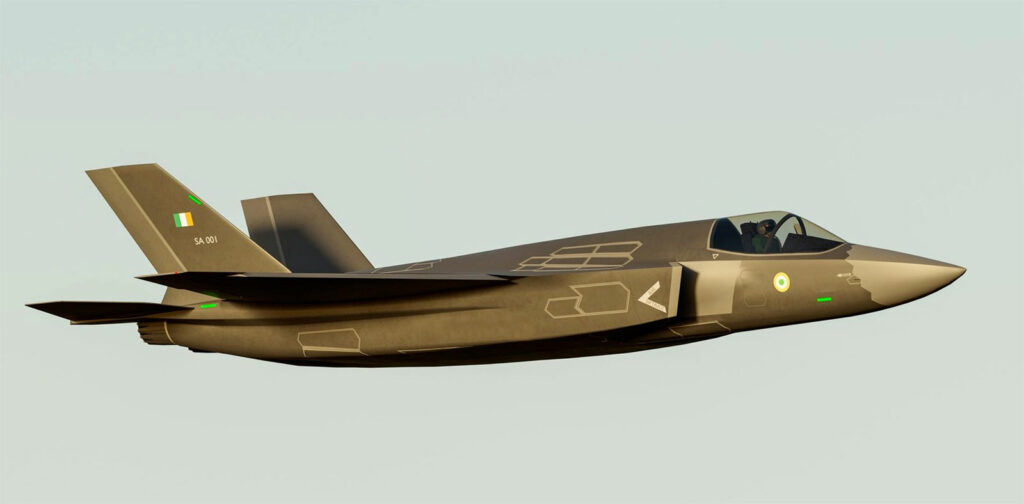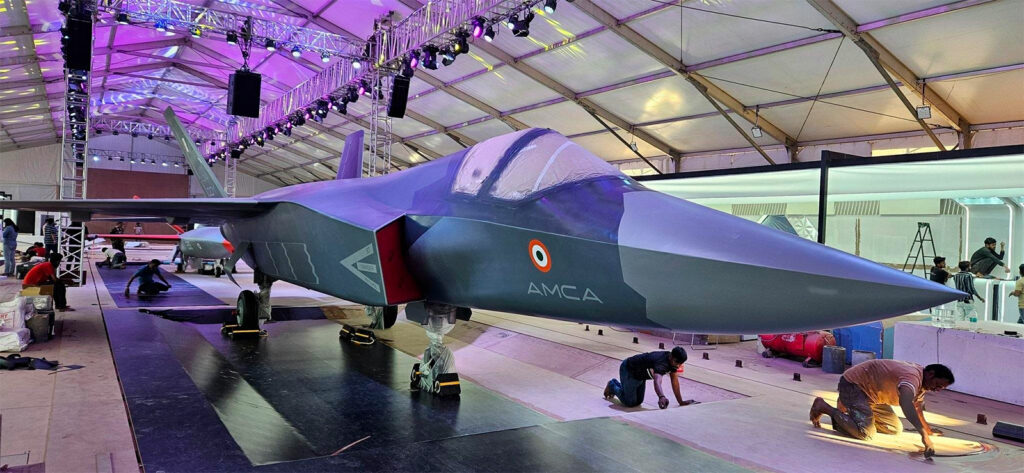Indigenous 5th gen stealth fighter, twin-engine, multirole HAL AMCA designed for Indian Air Force; AESA radar, 20,230 lbf engines.
The HAL AMCA (Advanced Medium Combat Aircraft) is a fifth-generation stealth multirole combat aircraft developed by India’s Aeronautical Development Agency (ADA) in collaboration with Hindustan Aeronautics Limited (HAL). The aircraft features twin engines, internal weapons bays, low-observable (stealth) design, and an Active Electronically Scanned Array (AESA) radar. Designed for air superiority, strike, and electronic warfare, the AMCA incorporates fly-by-wire controls, sensor fusion, and supercruise capabilities. The airframe includes a diamond-shaped wing planform, trapezoidal tailplanes, and angled air intakes. Initial versions will be powered by General Electric F414 engines (24,700 lbf each), with later models integrating indigenous Kaveri NG engines (20,230 lbf with afterburner). The aircraft is planned to achieve first flight in 2025 and enter service by 2030, supporting India’s strategic goal of indigenization and reducing dependency on foreign defense technologies.
History of the development of the HAL AMCA
The development of the HAL AMCA originates from India’s broader objective to create a fifth-generation indigenous combat aircraft capable of addressing contemporary threats in contested airspaces. The program was initiated in the backdrop of India’s dependence on imported platforms like the Sukhoi Su-30MKI, Mirage 2000, and MiG-29, as well as the limited success of the HAL Tejas (LCA) program, which faced long delays. With increasing regional security challenges and the induction of Chinese J-20s and Pakistani JF-17s, India recognized the need to develop a stealth-capable, high-performance fighter.
The Advanced Medium Combat Aircraft project officially began in 2008, led by the Aeronautical Development Agency (ADA) under the Ministry of Defence. Initial concept studies concluded in 2010, with the finalized configuration being showcased publicly at Aero India 2013. By 2015, the design was frozen, with government sanctioning approval for the prototype phase in subsequent years. The program was strategically important not only to modernize the IAF fleet but also to foster domestic aerospace capabilities and reduce dependency on joint ventures like the FGFA (Fifth Generation Fighter Aircraft) project with Russia, which was later shelved.
Originally, the AMCA was to be powered by the GTRE GTX-35VS Kaveri engine, developed indigenously by the Gas Turbine Research Establishment (GTRE). However, technical limitations in thrust-to-weight ratio and reliability led the development team to adopt the General Electric F414 engines for the first two prototypes. These engines, rated at 24,700 lbf (109.9 kN) with afterburner, provide sufficient thrust for supercruise and maneuverability.
In 2018, the Indian government approved seed funding for prototype development. The first Technology Demonstrator (TD-1) is scheduled for rollout in 2025, with five prototypes expected for testing and evaluation. The development roadmap anticipates operational clearance by 2030, in line with India’s long-term capability planning.
The AMCA is expected to complement the HAL Tejas Mk.2 and the Su-30MKI, while eventually replacing older airframes. It will serve as the primary fifth-generation fighter for the IAF. The aircraft will be produced in two phases: AMCA Mk.1, with foreign engines and current technologies, and AMCA Mk.2, featuring improved stealth, avionics, and an indigenous engine under co-development with international partners such as Safran (France).
The NATO designation for the AMCA, if assigned upon entry into Western defense databases, is not publicly known at this time.

Design of the HAL AMCA
The AMCA’s design reflects the hallmarks of fifth-generation aircraft. The airframe is built around stealth requirements, including reduced radar cross-section (RCS), infrared signature suppression, and internal weapons storage. The overall configuration is a single-seat, twin-engine, diamond-planform aircraft with a blended wing body, serrated edges, and angled surfaces to deflect radar waves.
The air intake is a diverterless supersonic inlet (DSI) mounted just aft of the cockpit, optimized to reduce radar reflections and improve airflow. The fuselage integrates composite materials and radar-absorbing coatings. The internal weapons bay is positioned near the centerline, capable of housing four beyond-visual-range (BVR) missiles or two BVR missiles plus two close-combat missiles, along with precision-guided bombs.
The main wings are mid-mounted with a trapezoidal geometry, offering high lift and low drag. Control surfaces include full-span leading-edge flaps, elevons, and ruddervators integrated into twin canted vertical stabilizers, which provide stability and maneuverability at high angles of attack. The horizontal tailplanes are positioned at the aft and operate in coordination with thrust vectoring nozzles for pitch control.
The airframe is expected to weigh between 45,000 and 55,000 lb (20,400 to 24,950 kg) depending on configuration. The maximum takeoff weight (MTOW) is projected at 77,000 lb (35,000 kg).
The cockpit features a glass cockpit layout with a large area multifunction display (LAD), helmet-mounted display (HMD), and voice-command interface. The avionics suite includes sensor fusion, electronic warfare (EW) systems, and multi-spectral targeting.
An AESA radar, likely a derivative of the Uttam radar developed by LRDE, provides high-resolution tracking, target acquisition, and ECM resistance. Infrared Search and Track (IRST) and advanced passive sensors will support long-range engagement and stealth operations.
Drawbacks include development risk associated with integrating indigenous systems, and the dependency on foreign engines until local production scales. Stealth capabilities are untested in real combat conditions, and radar signature performance is classified.
Performance of the HAL AMCA
The AMCA Mk.1 will initially use two General Electric F414-GE-INS6 engines, each delivering 24,700 lbf (109.9 kN) with afterburner and around 13,000 lbf (57.8 kN) dry. The engines offer supercruise capability and thrust vectoring for high maneuverability. The Mk.2 is expected to use an indigenous engine under development with Safran, delivering similar or improved performance.
The aircraft is projected to reach a maximum speed of Mach 2.15 (2,300 km/h or 1,429 mph) and supercruise at Mach 1.3 (1,400 km/h or 870 mph) without afterburners. The combat radius is estimated at 620 miles (1,000 km), and the ferry range with external tanks is around 1,864 miles (3,000 km). Service ceiling is expected to be 65,000 ft (19,812 m).
The AMCA features high angle-of-attack capabilities, digital flight control system, and triple-redundant fly-by-wire for precise handling. Stealth is enhanced through RCS reduction, internal payload, and low infrared signature.
When compared to contemporaries like the F-35 Lightning II, J-20, and Su-57, the AMCA is competitive on paper in thrust, stealth design, and radar capability. The F-35 surpasses it in network-centric warfare and mission systems, while the AMCA aims to offer supercruise and agility advantages. The Su-57 offers greater raw speed and larger payload but has faced issues with stealth fidelity.
Payload capacity is estimated at 16,500 lb (7,500 kg) including both internal and external stores. The aircraft will integrate advanced electronic warfare systems, decoys, countermeasures, and digital jammers. Its G-limit is expected to be +9G, allowing aggressive maneuvers.
Fuel is stored internally and augmented with external tanks if stealth is not required. In-flight refueling capability is included via probe-and-drogue system. Performance remains untested in live operations but matches contemporary benchmarks in simulations and wind tunnel tests.

Variants of the HAL AMCA
The HAL AMCA program is structured in two major variants:
AMCA Mk.1: This is the initial operational version, powered by twin GE F414-GE-INS6 engines. It will integrate most fifth-generation features including stealth shaping, internal weapons bay, AESA radar, and sensor fusion. Mk.1 serves as a stepping stone toward self-reliance while ensuring performance parity with global peers. Planned induction is around 2030, with a production target of 40 units.
AMCA Mk.2: The Mk.2 will include indigenous engines, co-developed by GTRE and Safran, offering improved thrust-to-weight ratio and potentially supercruise above Mach 1.5. The Mk.2 is expected to have enhanced stealth, improved avionics, and superior electronic warfare capabilities. It may also introduce additional mission adaptability for naval operations, with a possible carrier-based variant under study.
Other potential derivatives include a two-seat trainer version, but this remains conceptual. Export-oriented variants may emerge if diplomatic agreements and technology transfer conditions are met.
Military missions of the HAL AMCA
The AMCA is designed as a multirole stealth fighter, capable of executing a range of missions:
- Air superiority: Equipped with AAMs such as Astra Mk.1/2, Meteor, and Python-5, the AMCA will dominate airspace with beyond-visual-range engagement and high agility.
- Strike missions: The aircraft can deploy precision-guided munitions (PGMs), including SPICE-2000, SAAW, and laser-guided bombs internally, ensuring stealth integrity.
- Electronic warfare: With an integrated EW suite, decoys, and jammers, AMCA can suppress enemy air defenses and operate in contested airspace.
- SEAD/DEAD: Suppression and destruction of enemy air defenses will be supported by anti-radiation missiles and targeting pods.
- Reconnaissance: Multispectral sensors and data links allow real-time ISR missions.
Armament configuration includes:
- Internal bay: 4x BVRAAM or 2x BVRAAM + 2x SRAAM + PGMs
- External pylons (non-stealth missions): Up to 6 hardpoints
- Cannon: Integrated internal 23mm or 30mm gun
The AMCA is not yet exported and is solely intended for Indian Air Force operations. There is future export potential to countries like Vietnam, Egypt, and Indonesia under India’s defense diplomacy programs.
Competing aircraft include the F-35, J-20, Su-57, and KF-21. While F-35 dominates network-centric warfare, the AMCA emphasizes supercruise and cost-effective stealth. The J-20 outnumbers AMCA but lacks proven agility. The KF-21 is closer to 4.5 gen capability.
The AMCA is expected to serve until 2060, gradually replacing Mirage 2000, Jaguar, and MiG-29 platforms. No replacement is yet defined.
Back to the Fighter Jet section.